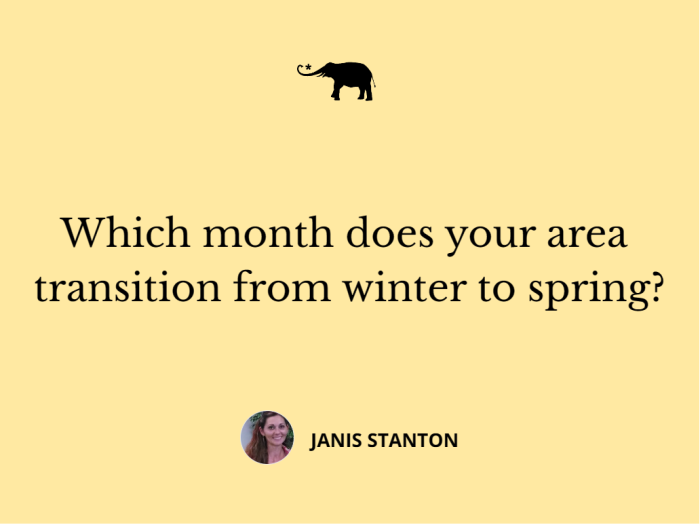Have you ever noticed yourself going through a transitional period?
Our land—Earth—goes through transitional periods, too. Letting your yard be while it transitions from winter to spring is helpful in so many ways.
An article about No Mow March popped up in one of my news feeds today, and it got me thinking. Luckily, I’ve lived in Florida long enough—30 years this August—to be familiar enough with the weather so that I wouldn’t mow until after March anyway.
I was born and raised up north, generally between Cincinnati and Chicago, and both go through their own transition from one season to another. I refer to Florida’s transition as being bipolar. Since Florida is my most recent climate, I’m using that frame of reference.
Please consider when and what changes your environment goes through while transitioning and adjust accordingly for what works best in your area.
Here, everything has started growing again because there’ve been many days in the 80s in the past month. But within a 36-hour window, the temperature will drop into the 40s, or possibly 30s. Instead of causing trauma by cutting the fresh new growth and disrupting its natural process at a delicate time, I prefer to let it be and allow my yard to take the time it needs to sprout new life. To move at its own pace into spring.
I don’t want to mow yet because it could hurt the natural process of my yard. Also, I don’t want to plant anything until after the last cold snap.
This is my third summer in this house, on this land. I’ve seen how the surrounding trees change through the seasons. Losing and re-growing their leaves. How they dance with the wind and get kissed by the sun. I’ve seen how the planted “Christmas” tree has grown over the three years since we moved in and planted it.
We’re currently worried about the hibiscus because it looks dead. It’s only been in the ground a little over a year. However, I do remember it looking dead this time last year, so I remain hopeful to see signs of life again soon.
Before long, mushrooms will also be growing. Predominately on the north side of the house where there is extra leaf and tree cover for it to stay moist, shaded, and warm. Perfect for mushrooms.
The “no mow” article I read reminded me that it’s important not to mow not just for my preference, but to support my yard’s native pollinators. I value having a yard that is friendly to butterflies, dragonflies, bees, and birds.
I enjoy watching winged creatures fly about—even the bats. I don’t like wasps though, and I will kill them if they try to settle too close to my living space, only as an act of self-defense. People are allergic to wasps, and they always like to try to make nests on my porch by the front door. I learned quickly to keep a can of wasp spray on the porch table for such instances, and that faux wasp nests can also be highly effective in moving them on.
The hibiscus I mentioned earlier has some growth around it. According to my Google Lens search, it is common vetch. The vetch provides some protection for the hibiscus by way of a reserve of nutrients—nitrogen and carbon—and water. Also, their pods have been referred to as poor man’s peas.
During the transitional period from winter to spring, it’s a great idea to leave this vegetation in place. Not only is it beneficial to the hibiscus, but it’ll flower to support local pollinators too. Plus, for sh*ts and giggles, I might try a peapod now that I know.
Once it’s well into spring and closer to summer temps, the yard will need to be mowed, including the vetch, to control overgrowth. Controlling overgrowth in my yard is also important because I’m a barefoot hippie and don’t want to step on anything unpleasant like a snake. Other family members prefer to be barefoot too, including young’uns. It’s nice to also be considerate of others, like the meter readers who need to be able to move through the yard.
I live in North-Central Florida, so a #NoMowMarch works for my area. A quick search provided me results that a No Mow May campaign started originally in Cornwall, United Kingdom in 2009. The seasonal transition from winter to spring happens at different times in different places. I encourage you to hold off mowing to give your yard a chance to adjust to the change first, whenever that change occurs. Maybe your area should support a No Mow April, or even October for those in the southern hemisphere.
When do you first see fresh, green leaves growing on the barren trees? When do you notice bees flying about to the various food sources popping up in your yard? Which spots do they favor? What colors are popping up in your yard?
I saw a baby dragonfly the other day and caterpillars have started crawling about, which tells me that the spring of life is arriving. (Unfortunately, being in Florida, that also means that lovebug season is coming soon.)
Why would we want to disrupt this beautiful cycle of nature?












Read 21 comments and reply